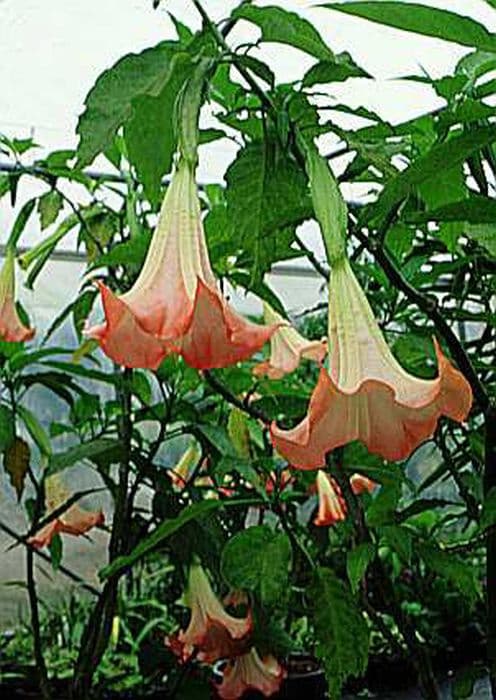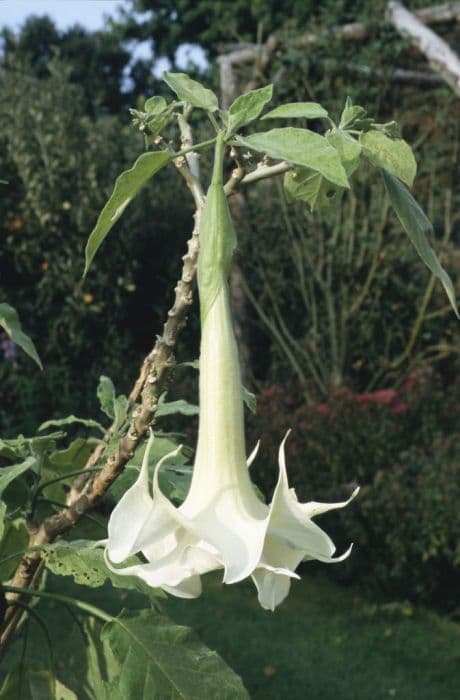Night Sky Petunia Petunia NightSky = 'Kleph15313'
![petunia [NightSky]](/_next/image?url=https%3A%2F%2Fplants-admin.emdemapps.com%2Fimages%2Fplants%2F%2Fimages%2F604b5cba8d2a9.png&w=3840&q=75)
ABOUT
The Petunia NightSky, known for its striking flower pattern, displays a deep purple or violet hue that is interspersed with white speckles or flecks, reminiscent of a starry night sky. This distinctive pattern gives each blossom a unique appearance, as no two flowers are exactly alike in their speckling. The contrast between the dark background color and the bright white spots creates a dramatic visual effect, capturing the attention of gardeners and plant enthusiasts alike. The blooms of the Petunia NightSky are large and funnel-shaped, typical of petunias, with a velvety texture. They grow in abundance, creating a lush display of color and pattern. The foliage is equally lush, with green leaves that provide a backdrop to highlight the beauty of the flowers. This plant is known for its continuous blooming throughout the growing season, which adds to its popularity as a decorative choice for outdoor spaces.
About this plant
 Names
NamesFamily
Solanaceae.
Synonyms
NightSky Petunia, Galaxy Flower.
Common names
Petunia NightSky = 'Kleph15313'
 Toxicity
ToxicityTo humans
Petunias, including the Petunia NightSky variety, are generally considered non-toxic to humans. There are no significant toxic effects expected if any part of the plant is ingested accidentally in small quantities. However, it is not intended for consumption, and eating plant material may cause mild gastrointestinal discomfort due to the presence of naturally occurring compounds in the plant. It is always advised to avoid eating ornamental plants as a precaution.
To pets
Petunias, including the Petunia NightSky variety, are considered non-toxic to pets such as dogs and cats. If a pet ingests part of this plant, there is no expectation of serious toxicity. While the plant is not harmful, ingestion can sometimes lead to mild gastrointestinal upset, such as vomiting or diarrhea, due to the ingestion of non-food plant material. It is always a good practice to prevent pets from eating ornamental plants as some pets may have individual sensitivities or allergies.
 Characteristics
CharacteristicsLife cycle
Annuals
Foliage type
Deciduous
Color of leaves
Green
Flower color
Mixed
Height
1 foot (30 cm)
Spread
1 foot (30 cm)
Plant type
Herb
Hardiness zones
9
Native area
South America
Benefits
 General Benefits
General Benefits- Decorative Appeal: The 'NightSky' Petunia features a striking pattern that resembles a starry night, which can enhance the visual appeal of any garden.
- Easy to Grow: It is known for being easy to care for and can flourish in a variety of environments, making it suitable for gardeners of all skill levels.
- Continuous Blooming: This variety of petunia blooms profusely throughout the growing season, providing a long-lasting display of color.
- Attracts Pollinators: The vibrant flowers attract bees, butterflies, and other pollinators, supporting local ecosystems.
- Versatility: Suitable for container gardens, hanging baskets, and bedding, offering flexibility in garden design and use of space.
- Drought Tolerance: Once established, they can tolerate short periods of drought, reducing the need for constant watering.
 Medical Properties
Medical PropertiesThis plant is not used for medical purposes.
 Air-purifying Qualities
Air-purifying QualitiesThis plant is not specifically known for air purifying qualities.
 Other Uses
Other Uses- Natural Fabric Dye: The deep violet and speckled white of NightSky Petunias can be used to create unique, natural fabric dyes for textile projects.
- Photography Subject: The distinctive pattern of NightSky Petunias makes them an excellent subject for botanical photography, appealing to enthusiasts and professionals alike.
- Artistic Inspiration: Artists may find the unique coloring of the NightSky Petunia stimulating, possibly leading to paintings, drawings, or other forms of artistic expression.
- Educational Tool: Educators can use NightSky Petunias to illustrate genetic variability and the influence of breeding in botany lessons.
- Garden Thematic Design: The striking appearance of NightSky Petunias is perfect for gardeners looking to create a star-themed garden or a night sky simulation.
- Culinary Garnish: While not commonly consumed, the petals of NightSky Petunias can be used as an ornate and colorful garnish for upscale culinary dishes.
- Event Decorations: Due to their unique appearance, NightSky Petunias can serve as decorative elements for nighttime events or celestial-themed parties.
- Creative Crafting: Pressed NightSky Petunia flowers can be incorporated into crafts like homemade cards, bookmarks, or decoupage projects.
- Ikebana (Japanese Flower Arranging): The distinct look of NightSky Petunias adds a modern twist to the traditional art of ikebana, offering a new element for arrangements.
- Bath Bombs: Though unconventional, the petals of NightSky Petunias could be incorporated into homemade bath bombs for a splash of color and surprise in the tub.
Interesting Facts
 Feng Shui
Feng ShuiThe Petunia is not used in Feng Shui practice.
 Zodiac Sign Compitability
Zodiac Sign CompitabilityThe Petunia is not used in astrology practice.
 Plant Symbolism
Plant Symbolism- Anger and Resentment: Petunias, in general, have sometimes been associated with feelings of anger and resentment due to their somewhat aggressive growth habits.
- Desire and Passion: The deep colors and vast patterns of the NightSky Petunia can evoke a sense of mystery and depth, often associated with intense emotions like desire and passion.
- Comforting the Soul: The NightSky pattern, resembling a starry sky, is thought to offer a sense of calm and comfort, similar to looking up at the night sky.
 Water
WaterNight Sky Petunias require regular watering to ensure the soil stays moist but not soggy. They should ideally be watered with about 1 gallon per square foot every week, but this may need to be adjusted depending on weather conditions and soil type. During hot, dry periods, watering may need to be increased. Water the plants at the base to avoid wetting the foliage, which can lead to fungal diseases. Always check the top inch of the soil before watering; if it's dry, it's time to water.
 Light
LightNight Sky Petunias thrive in full sun conditions, which means they need at least six hours of direct sunlight daily. The best spot for these petunias is in a location where they can receive unfiltered sunlight for most of the day. If necessary, morning sun with some afternoon shade is also acceptable to protect them from extremely high temperatures.
 Temperature
TemperatureNight Sky Petunias prefer temperatures between 60 and 85 degrees Fahrenheit. They can tolerate a minimum temperature of around 40 degrees Fahrenheit but will not survive frost conditions. The ideal temperature range supports healthy growth and abundant flowering.
 Pruning
PruningPruning Night Sky Petunias encourages bushier growth and more blooms. Pinch off the tips of the stems when the plant is young, and regularly deadhead spent flowers to promote continuous blooming. Pruning is ideally done in the early morning or evening, and it should be performed every two to three weeks during the blooming season.
 Cleaning
CleaningAs needed
 Soil
SoilPetunia NightSky prefers a well-draining, fertile potting mix with a good amount of organic matter. Add pine bark or perlite to enhance drainage. The optimal soil pH for this plant should range between 5.5 and 6.5.
 Repotting
RepottingNight Sky Petunia should typically be repotted once a year during the spring. The growth rate can demand biannual repotting, especially if the petunia becomes root-bound or outgrows its container.
 Humidity & Misting
Humidity & MistingNight Sky Petunias fare well in moderate ambient humidity levels ranging from 40% to 70%. Avoid overly dry air which can stress the plant.
 Suitable locations
Suitable locationsIndoor
Give Night Sky Petunias bright light and well-draining soil.
Outdoor
Plant in sunny locations with fertile, well-draining soil.
Hardiness zone
9-11 USDA
 Life cycle
Life cycleThe life of Petunia NightSky, commonly known as Starry Night Petunia, begins with seed germination, which requires warm soil and typically takes 5-15 days. The seedlings then enter a vegetative state, developing leaves and stems; this stage requires ample sunlight and water. Following the vegetative stage, the plant enters the flowering stage when it reaches maturity, where the characteristic purple flowers with white speckles resembling a starry night appear. Flowering lasts throughout the warm months and can be prolonged with regular deadheading of spent blooms. As temperatures drop, the plant enters senescence, where it begins to die back, especially if it is exposed to frost, as it is not frost-tolerant. The cycle can continue with the collection of seeds from the mature plant, or it may be treated as an annual and replanted the following season.
 Propogation
PropogationPropogation time
Spring-Early Summer
The Petunia NightSky, known for its striking flowers speckled with white which resemble a starry sky, can be propagated through various methods. The most popular method is through seed propagation. The best time to sow petunia seeds is late winter or early spring, allowing seedlings to be ready for transplant once the danger of frost has passed. Sowing the seeds involves carefully sprinkling them onto the surface of a well-drained seed starting mix, as they need light to germinate. Care must be taken not to cover the seeds with soil. Maintaining a consistent temperature of 70 to 75 degrees Fahrenheit (21 to 24 degrees Celsius) and providing plenty of light will encourage germination, typically within 7 to 10 days. After germination, seedlings should be thinned and eventually transplanted outdoors after hardening off to ensure they are acclimated to outdoor conditions.


![Calibrachoa [Aloha Classic Blue Sky]](/_next/image?url=https%3A%2F%2Fplants-admin.emdemapps.com%2Fimages%2Fplants%2F%2Fimages%2F604b636c3778b.png&w=640&q=75)
![Calibrachoa [Aloha Classic Gold]](/_next/image?url=https%3A%2F%2Fplants-admin.emdemapps.com%2Fimages%2Fplants%2F%2Fimages%2F604b6284c573e.png&w=640&q=75)
![Calibrachoa [Aloha Classic Tiki Soft Pink]](/_next/image?url=https%3A%2F%2Fplants-admin.emdemapps.com%2Fimages%2Fplants%2F%2Fimages%2F604b548e0a5ef.png&w=640&q=75)
![Calibrachoa [Cabaret Deep Yellow]](/_next/image?url=https%3A%2F%2Fplants-admin.emdemapps.com%2Fimages%2Fplants%2F%2Fimages%2F604b5f20ca3ef.png&w=640&q=75)
![Calibrachoa [Calibasket Radiant Orange]](/_next/image?url=https%3A%2F%2Fplants-admin.emdemapps.com%2Fimages%2Fplants%2F%2Fimages%2F604b536d43cb2.png&w=640&q=75)
![Calibrachoa [Caloha Classic Blue Velvet]](/_next/image?url=https%3A%2F%2Fplants-admin.emdemapps.com%2Fimages%2Fplants%2F%2Fimages%2F604b604884a75.png&w=640&q=75)
![Calibrachoa [Caloha Classic Honey White]](/_next/image?url=https%3A%2F%2Fplants-admin.emdemapps.com%2Fimages%2Fplants%2F%2Fimages%2F604b5f56e0beb.png&w=640&q=75)
![Calibrachoa [Caloha Classic Yellow Chocolate Ring]](/_next/image?url=https%3A%2F%2Fplants-admin.emdemapps.com%2Fimages%2Fplants%2F%2Fimages%2F604b538aede95.png&w=640&q=75)